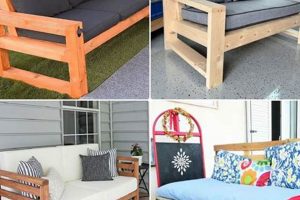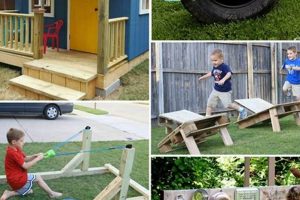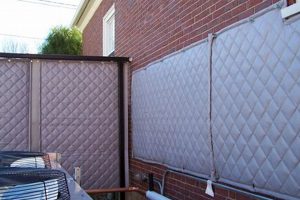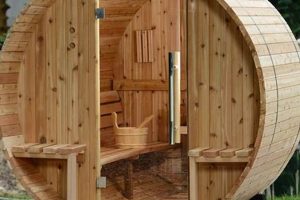The creation of an at-home fitness station, specifically for upper body strength training, using readily available materials is a growing trend. This endeavor typically involves constructing a horizontal bar, suitable for performing calisthenics exercises, in an exterior environment. The process often leverages ingenuity and basic construction skills to establish a personalized workout space.
Constructing a personal fitness apparatus offers several advantages. It promotes physical well-being by enabling convenient strength training, reduces reliance on commercial gyms, and fosters a sense of accomplishment through hands-on building. Historically, resourceful individuals have adapted their environments for exercise, demonstrating a long-standing desire for accessible physical conditioning. This DIY approach reflects a commitment to self-sufficiency and personalized fitness regimens.
The subsequent discussion will detail different construction methods, material considerations, and safety protocols to ensure a robust and effective training tool. Furthermore, the long-term maintenance and modifications to enhance functionality will be addressed.
Construction Guidance
The following points highlight crucial factors for achieving a secure and functional at-home fitness station. Adherence to these guidelines will significantly enhance the safety and longevity of the structure.
Tip 1: Material Selection: Opt for pressure-treated lumber or metal specifically designed for outdoor use. This choice mitigates the risk of rot, insect infestation, and corrosion, thereby extending the lifespan of the apparatus.
Tip 2: Structural Integrity: Prioritize robust joints and secure fastenings. Employ bolts and screws of appropriate length and gauge to withstand the forces generated during exercise. Consider reinforcing joints with metal brackets for added stability.
Tip 3: Ground Anchoring: Securely anchor the structure to the ground. Concrete footings or buried support posts are essential to prevent tipping or movement during use. Ensure proper drainage around the base to minimize moisture accumulation.
Tip 4: Bar Diameter and Grip: Select a bar diameter that facilitates a secure grip. A diameter between 1.25 and 1.5 inches is generally suitable for most individuals. Consider adding textured tape or knurling for enhanced grip.
Tip 5: Height Considerations: Determine the appropriate height based on the user’s reach. The bar should be high enough to allow for full extension of the arms without touching the ground, but not so high that it becomes difficult to reach.
Tip 6: Safety Zone: Establish a clear safety zone around the apparatus. Ensure that there are no obstructions, such as trees, fences, or other structures, within a reasonable radius. Consider placing a mat underneath to cushion any potential falls.
Tip 7: Regular Inspection: Conduct regular inspections to identify any signs of wear, damage, or instability. Tighten loose fasteners, replace damaged components, and address any issues promptly to maintain safety.
Consistent application of these recommendations will promote the construction of a safe, durable, and effective fitness tool. By prioritizing material quality, structural soundness, and user safety, the long-term benefits of the construction will be maximized.
The subsequent section will address specific design options and considerations for customizing to meet individual requirements.
1. Material Durability
The longevity and safety of a constructed outdoor fitness apparatus are inextricably linked to the selection of durable materials. The sustained exposure to environmental elements, including precipitation, solar radiation, and temperature fluctuations, necessitates the use of materials resistant to degradation. Premature failure of components due to rust, rot, or structural weakening can compromise the integrity of the fitness station, posing a significant risk of injury. The cause-and-effect relationship is evident: inferior materials yield a short lifespan and increased safety hazards, while robust materials ensure structural integrity and prolonged usability.
Consider the example of untreated lumber versus pressure-treated lumber in the construction of the support posts. Untreated lumber is susceptible to fungal decay and insect infestation, potentially leading to structural failure within a relatively short timeframe. In contrast, pressure-treated lumber, having undergone a chemical process to resist these threats, exhibits significantly enhanced durability. Similarly, galvanized steel or powder-coated metal components offer superior resistance to corrosion compared to untreated steel, reducing the risk of structural weakening due to rust. The choice of appropriate materials directly translates into a safer and more durable fitness apparatus.
The practical significance of understanding material durability lies in the ability to make informed purchasing decisions. By prioritizing materials engineered for outdoor use and demonstrating resistance to environmental stressors, the builder ensures a structurally sound and long-lasting fitness station. The initial investment in durable materials is offset by reduced maintenance costs, extended lifespan, and, most importantly, enhanced user safety, further demonstrating the importance of “Material Durability”. Challenges remain in balancing cost with desired lifespan and aesthetic considerations, but these factors must be assessed within the framework of ensuring a safe and reliable exercise environment.
2. Structural Stability
The successful implementation of a “pull up bar outdoor diy” project hinges critically on its structural stability. This attribute dictates the apparatus’s capacity to withstand applied forces and maintain its intended form under stress, directly influencing user safety and equipment longevity. Any deficiency in structural stability creates a direct and quantifiable risk of collapse or failure, potentially leading to severe injury. This risk mandates a thorough understanding of the principles governing structural mechanics, material properties, and load distribution.
For example, consider a DIY design utilizing inadequate support post dimensions or insufficient ground anchoring. Under the dynamic load exerted during exercise, such a structure may exhibit excessive deflection, instability, or catastrophic failure. Conversely, a design employing appropriately sized and braced support structures, coupled with robust ground anchoring techniques (e.g., concrete footings), ensures the safe transfer of forces to the ground, maintaining stability even under peak loading conditions. This difference illustrates the practical significance of meticulous planning and execution regarding structural aspects.
In conclusion, structural stability is not merely a desirable attribute but a fundamental requirement for any “pull up bar outdoor diy” undertaking. Ensuring sufficient strength, rigidity, and secure anchoring through appropriate design and construction practices is paramount to mitigating risks and maximizing the long-term utility of the fitness apparatus. Challenges may arise in balancing cost considerations with structural integrity, but safety should always be prioritized. Comprehensive assessment of load-bearing capacity and diligent adherence to established construction standards are essential for a successful and safe project.
3. Weather Resistance
Weather resistance is a critical determinant of the long-term viability of any outdoor fitness apparatus. The exposure to rain, snow, solar ultraviolet radiation, and temperature variations directly affects the structural integrity and aesthetic appeal of a constructed station. The consequences of inadequate protection against these environmental factors manifest as corrosion, decay, fading, and ultimately, structural failure. The direct correlation is evident: insufficient weather resistance leads to premature degradation, necessitating costly repairs or replacement, and potentially creating safety hazards.
For instance, consider the construction of a station using unprotected steel components. Without proper coating or treatment, these components are susceptible to oxidation, leading to rust formation and a gradual weakening of the metal. Similarly, untreated wood exposed to moisture and sunlight can rot, warp, and crack, compromising the structural integrity of the entire assembly. In contrast, utilizing pressure-treated lumber and applying weather-resistant coatings, such as paint or sealant, significantly extends the lifespan of the apparatus by shielding it from the damaging effects of the environment. The proper choice of materials and protective treatments represents a practical application of weather resistance principles.
The significance of understanding weather resistance lies in its direct impact on both the cost and safety of an outdoor fitness project. The implementation of appropriate protective measures minimizes maintenance requirements, reduces the likelihood of structural failure, and ensures a safe exercise environment for users. While initial costs may increase with the use of weather-resistant materials and treatments, the long-term savings in terms of reduced repairs and replacement costs outweigh the initial investment. Challenges in accurately assessing the severity of environmental exposure at a specific location remain, emphasizing the need for conservative material selection and preventative maintenance strategies.
4. User Safety
The paramount consideration in any “pull up bar outdoor diy” endeavor is user safety. The potential for injury associated with improper construction, inadequate material selection, or flawed design necessitates a rigorous focus on safety protocols throughout the entire process. Any deviation from established safety guidelines directly elevates the risk of falls, strains, fractures, or other serious physical harm. The cause-and-effect relationship is irrefutable: compromised safety measures translate directly into increased likelihood of injury.
For example, failure to adequately secure the structure to the ground, utilizing insufficient anchoring methods, can result in instability and collapse during use. Similarly, using undersized or improperly fastened components can lead to structural failure under the dynamic load of exercise, potentially resulting in significant injuries. Moreover, neglecting to smooth rough edges or address protruding hardware creates a hazardous environment, increasing the risk of cuts and abrasions. Prioritizing a well-designed safety zone around the apparatus, free from obstructions, serves as a preventative measure against impact injuries.
In conclusion, user safety is not merely an ancillary concern but an indispensable element of “pull up bar outdoor diy.” Diligent adherence to safety standards, including thorough planning, robust construction techniques, and the implementation of preventative measures, is essential for mitigating risks and ensuring a secure exercise environment. While challenges may arise in balancing cost considerations with stringent safety requirements, user well-being should always take precedence. A proactive approach to safety, coupled with regular inspections and maintenance, is crucial for maximizing the benefits of the apparatus while minimizing the potential for harm.
5. Height Adjustment
The capacity for vertical modulation is a significant factor in the design and utility of a fitness station intended for outdoor, user-assembled construction. The absence of height adjustability restricts the apparatus’s usability to individuals within a limited anthropometric range. This limitation reduces the inclusivity of the device and potentially compromises the effectiveness of exercises performed. The incorporation of mechanisms for varying the height of the horizontal bar directly expands the range of potential users and enables a wider array of exercises. A consequence of neglecting height adjustment is the exclusion of individuals who may be unable to safely or effectively utilize a fixed-height bar.
Consider, for example, a fitness apparatus erected with a fixed bar height optimized for an individual of average stature. Children, shorter adults, or individuals with limited shoulder mobility may find the bar inaccessible or difficult to utilize with proper form. Conversely, taller individuals may be forced to perform exercises with a compromised range of motion, reducing the effectiveness of the workout and increasing the risk of injury. Implementing adjustable height settings, through the use of telescoping supports, pin-and-hole mechanisms, or modular extensions, allows for customization to accommodate diverse user needs and exercise requirements. This adjustment ensures proper biomechanics, maximizes exercise efficacy, and enhances user safety.
In summary, height adjustment is a critical feature in fitness apparatus projects intended for self-assembly. The inclusion of adjustable height settings promotes inclusivity, enhances exercise effectiveness, and minimizes the risk of injury. While the implementation of such features may introduce additional complexity and cost, the benefits in terms of user accessibility and safety justify the added effort. The challenge lies in developing cost-effective and robust adjustment mechanisms that maintain structural integrity and withstand the rigors of outdoor use, highlighting the inherent design constraints and trade-offs involved.
6. Anchoring Method
The method of securing a self-assembled outdoor fitness apparatus is intrinsically linked to its structural integrity and user safety. The apparatus, specifically a pull-up bar, must withstand significant dynamic forces during exercise. The chosen anchoring strategy directly determines the resistance to these forces, preventing movement, tipping, or complete structural failure. Inadequate anchoring compromises the entire system, negating any benefits derived from material selection or design considerations. A real-world example involves a structure utilizing shallow footings; the leverage exerted during a pull-up can overcome the soil’s resistance, leading to gradual tilting and eventual collapse. Understanding soil mechanics and load distribution is therefore paramount.
Different anchoring methods offer varying degrees of stability and are suitable for different soil conditions and apparatus designs. Concrete footings, extending below the frost line, provide a robust and permanent solution, particularly in areas with unstable soils. Ground anchors, driven deep into the earth, offer a less invasive alternative, suitable for temporary installations or locations where concrete is impractical. Surface mounting with weighted bases is another option, although it generally provides the least stability and is susceptible to movement, particularly on uneven ground. The selection process should consider the apparatus dimensions, the anticipated load, soil type, and prevailing environmental conditions, all integral components of successful design and construction.
In summary, the anchoring method represents a foundational aspect of constructing a secure and functional outdoor fitness station. Its effectiveness directly translates to the safety and usability of the apparatus. Challenges arise in balancing cost, ease of installation, and long-term stability, requiring careful evaluation of available options and site-specific conditions. Proper implementation, informed by engineering principles and practical experience, is essential for realizing the intended benefits of a self-assembled outdoor fitness tool while minimizing the risk of injury or structural failure.
Frequently Asked Questions
The following section addresses common inquiries regarding the construction of an outdoor fitness apparatus. The responses aim to provide clear and concise information to assist in the safe and effective completion of such projects.
Question 1: What is the minimum recommended depth for concrete footings supporting a pull-up bar structure?
The depth of concrete footings should extend below the frost line in the relevant geographic area to prevent heaving due to freeze-thaw cycles. Consultation with local building codes is recommended to determine the specific frost line depth. In the absence of such information, a minimum depth of 36 inches is generally considered adequate in temperate climates.
Question 2: What type of wood is most suitable for outdoor construction of a fitness apparatus?
Pressure-treated lumber, specifically rated for ground contact, is the preferred material. This lumber has undergone a chemical process to resist decay, insect infestation, and fungal growth, extending its lifespan in outdoor environments. Redwood and cedar are naturally decay-resistant alternatives, although they may be more expensive.
Question 3: Is it necessary to apply a sealant or protectant to pressure-treated lumber?
While pressure treatment provides significant protection, applying a sealant or stain with UV protection can further enhance the lumber’s resistance to weathering and prolong its lifespan. It also helps to maintain its aesthetic appearance.
Question 4: What is the recommended diameter for a pull-up bar intended for general use?
A diameter between 1.25 and 1.5 inches is generally suitable for most adult users. This range provides a comfortable and secure grip. The specific diameter should be selected based on individual hand size and grip strength.
Question 5: How can the risk of slippage be minimized on a metal pull-up bar?
Applying textured grip tape or knurling to the bar surface significantly improves grip and reduces the risk of slippage, particularly in wet or humid conditions. Regular cleaning of the bar is also essential to remove dirt and grime that can compromise grip.
Question 6: What are the key considerations when selecting hardware (bolts, screws, etc.) for outdoor construction?
Stainless steel or galvanized hardware is essential to prevent corrosion. The hardware should be appropriately sized and rated for the anticipated load. Using washers to distribute the load and prevent damage to the wood is also recommended.
The responses provided offer guidance on key aspects of outdoor fitness apparatus construction. Adherence to these recommendations promotes safety, durability, and functionality.
The following section will outline potential modifications and upgrades to enhance the functionality of an outdoor fitness apparatus.
Conclusion
The preceding discussion has detailed essential aspects of the fitness apparatus. Proper planning, robust construction, and diligent maintenance are not merely suggestions, but requirements for a safe and effective long-term training solution. Neglecting any of these factors significantly increases the potential for structural failure and subsequent injury.
Successful implementation demands rigorous adherence to safety protocols and a commitment to ongoing assessment. Diligence will ensure the long-term reliability and contribute to personal fitness goals.







